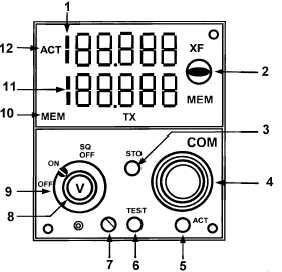TM 1-1510-218-10
3A-9
d. Emergency Operation.
NOTE
Transmission on emergency frequency,
121.500
MHz,
will
be
restricted
to
emergencies
only.
An
emergency
frequency of 243.000 MHz, guard channel,
is also available on the UHF command
radio set.
1. Transmitter selector switch – VHF 1 or
VHF 2.
2. Frequency selector, VHF control panel
–
121.500 MHz,
emergency
frequency.
3. Microphone switch – Press.
3A-10. VHF COMMUNICATIONS TRANSCEIVERS
(VHF-22D).
a. Introduction. The VHF communications
transceivers are an 8.33 kHz channel spacing cable
system. The operation between the 25 kHz and
8.33 kHz modes is seamless. Within the space
occupied by each 2 5 kHz frequency exist three
8.33 kHz channels. The 8.33 kHz "frequency" is
referred to as a "channel," not the actual frequency
tuned. The channel scheme avoids possible confusion
associated with shared 25 kHz and 8.33 kHz
frequencies. This method ensures that the equipment
will always be operating in the proper spacing mode
and occurs automatically as the user tunes the
controller. Provides airborne VHF communications
from 118.000 through 151.975 MHz and is operated by
two CTL-22C transceiver control units. Refer to Figure
3A-5.
The solid-state transceiver includes capture-
effect automatic squelch to help prevent missed radio
calls, plus audio leveling and response shaping to
ensure audio quality. Transmitter sidetone comes
from detected transmitter signal, and is therefore a
reliable check of transmission quality. Each VHF
transceiver is powered through its respective circuit
breaker, placarded VHF # 1 or VHF # 2, located on the
circuit breaker panel.
b. Operating Controls. All operating controls
for the transceivers are located on the CTL -22C
transceiver control units. Refer to Figure 3A-5.
(1) Active Frequency Display. Displays the
active frequency (frequency to which the transceiver is
tuned) and diagnostic messages.
(2) Transfer / Memory Switch. This switch is
a three-position spring-loaded toggle switch placarded
XF / MEM, which, when held to the XF position,
causes the preset frequency to be transferred up to
the active display and the transceiver to be returned.
The previously active frequency will become the new
preset frequency and will be displayed in the lower
window. When this switch is held to the MEM position,
one of the six stacked memory frequencies will be
loaded into the preset display. Successive pushes will
cycle the six memory frequencies through the display
(...2, 3, 4, 5, 6, 1, 2, 3...).
1. Active Frequency Display
2. Transfer/Memory Switch
3. Store Button
4. Frequency Select Knobs
5. Active Button
6. Test Button
7. Light Sensor
8. Volume Control
9. Power and Mode Switch
10. MEM TX Annunciators
11. Preset Frequency Display
12. Compare Annunciator
Figure 3A-5. VHF Communications Transceiver Control Unit – CTL-22C

